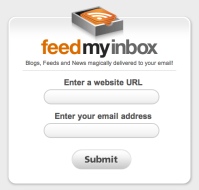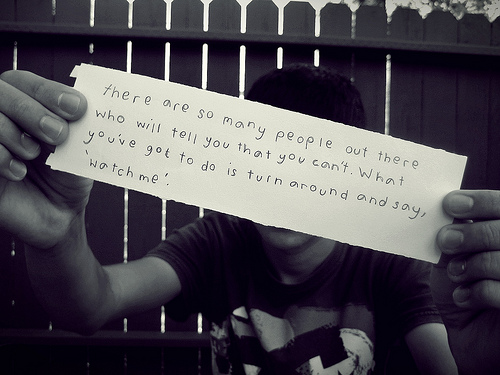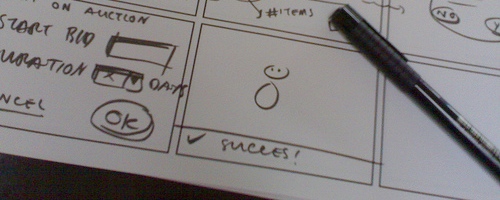Things I learned this week – #1
This is the first of a planned weekly series in which I reflect on what I’ve learned during the previous 7 days. As I explained in My digital reading workflow these links are culled from blogs and tweets I read.
Happy New Year! Feeling guilty because you haven’t made a New Year’s Resolution? Perhaps you could try the New Year’s Resolution Generator! (via swissmiss) It came up with ‘This year I will… declutter’ which seemed most prescient for me. 🙂 I’ve already made my Commitments for 2010 but for those who need things broken down step-by-step, they could do worse I suppose than try out mySomeday (via Mashable). Oh, and Zen Habits claims to have The Definitive Guide to Sticking to Your New Year’s Resolutions. 😀
Before I go any further I must point you in the direction of this eye-candy:
[youtube=http://www.youtube.com/watch?v=17jymDn0W6U&w=480&h=385]
The Known Universe by the American Museum of Natural History zooms from the Himalayas to deep space (via FlowingData)
100 Extraordinary Examples of Paper Art (via BoingBoing)
While we’re on the subject of design, swissmiss had a useful blog post on Japanese design principles. There are seven basic principles:
- Fukinsei (imbalanced)
- Kanso (simple)
- Kokou (austere)
- Shizen (natural)
- Yugen (subtle profound)
- Datsuzoko (unworldly)
- Seijaku (calm)
I’d like to think that this blog has elements of 2, 5 and 7. 😉
Not that I write much any more, but I was interested to (re-)discover that some people claim to be able to tell whether a person’s handwriting is ‘male’ or ‘female’. To be fair, if they managed to decipher mine they would only be able to tell that it was ‘messy’… In other quirky news (for which BoingBoing is an excellent source), it turns out that “there are more people currently alive in Asia, Africa and Latin America than the total number of people who died—anywhere, and for any reason—during the entire 20th century.” Wow. More at Census of the dead, in infographic form.
 It’s been 5 years, apparently, since Google first started blogging. They’ve no got so many blogs that it’s difficult to keep up with them all. If you, like me, are becoming overwhelmed by the unread items in your RSS reader, why not get everything delivered by email? If you’ve got a decent system (see my How I deal with email) it can be a very efficient way of keeping up-to-date. The trouble is, of course, that some blogs don’t have an subscribe-by-email option. That’s where FeedMyInbox is useful. Enter website URL and your email address and, hey presto! If you want a quick-and-easy way of getting all of the links from your Twitter followers, try ReadTwit. It creates an RSS feed of tweets that contain links from people you follow. You can put that through FeedMyInbox too. And if all that sounds like too much effort, why not try LazyFeed? (via @heyjudeonline) :-p
It’s been 5 years, apparently, since Google first started blogging. They’ve no got so many blogs that it’s difficult to keep up with them all. If you, like me, are becoming overwhelmed by the unread items in your RSS reader, why not get everything delivered by email? If you’ve got a decent system (see my How I deal with email) it can be a very efficient way of keeping up-to-date. The trouble is, of course, that some blogs don’t have an subscribe-by-email option. That’s where FeedMyInbox is useful. Enter website URL and your email address and, hey presto! If you want a quick-and-easy way of getting all of the links from your Twitter followers, try ReadTwit. It creates an RSS feed of tweets that contain links from people you follow. You can put that through FeedMyInbox too. And if all that sounds like too much effort, why not try LazyFeed? (via @heyjudeonline) :-p
Talking of productivity, Hans de Zwart (who has recently been promoted to the cool-sounding Innovation Manager: Learning Technology) has a great post on The Influence of a Workspace on Performance. In it, Hans cites a book by Alain de Botton, The Architecture of Happiness of which I wasn’t aware. His main thrust is highlighting the discrepancy between the exquisitely designed office space he works in, designed by David Leon, and the stupidity (his word) of being locked down to Windows 2000 and Internet Explorer 6. As Hans quotes David Leon as saying,
Innovation depends on bright people. These people cost more and are far more valuable than the buildings they occupy… but it is a proven fact that the environment in which they work has a major impact on their effectiveness.
For that reason we design workplaces and buildings round the needs of people and the business aims of their organisations.
He contends – and I agree – that should go for digital surroundings as well as physical surroundings. I recently reorganized my study, including building my own desk, to get things just right. 🙂
Motivation and productivity can be affected by surroundings, but a great deal of it comes from within. As Chris Guillebeau notes, there will always be people who say that you “can’t” do something. His reply (or rather, that of one of his readers) is:
Reading a lot of books is definitely a worthwhile thing to do, but one that takes dedication and motivation. How To Read a Book a Week in 2010 (via @chrisbrogan) is a useful reminder as to why setting yourself a definite target (e.g. one per week) is more useful than a hazy one (e.g. read more books).
And finally, some quotations I came across that I warmed to immediately. The first comes from a blog post on The Innovative Educator entitled My Top 20 Education Quotes from 2009:
Many of the most brilliant and creative people didn’t really discover what they could do and who they were until they’d left school and recovered from their education.
Minds are like parachutes – they only function when open. Thomas Dewar (via @timekord)
If you can find something everyone agrees on, it’s wrong – Mo Udall (via @russeltarr)
The only one thing I can change is myself, but sometimes that makes all of the difference. (via @Vincent_Ang)
Stuff to which I didn’t find a segue:
- 15 Incredibly Useful WordPress Plugins to Boost your Blog [WebDesignCore]
- Channel 4’s 4oD channel on YouTube (and demandfive)
- Free books for secondaries to get pupils ‘hooked on reading’ [Guardian UK]
- herebetwitterers [map visualization of Twitter friends]
- How to Find Anything Online: Become an Internet Research Expert [Webdesigner Depot]
- in education [peer-reviewed free-access online education journal]
- Open isn’t so open any more [Connectivism blog]
- Professional Conference Video With Semi-Professional Equipment [dy/dan]
- Put a name on it [Seth’s blog]
- The Essential Zen Habits of 2009 [Zen Habits]
Can’t wait until next week? See the tweets I favourite in real-time at http://twitter.com/dajbelshaw/favorites




![Reblog this post [with Zemanta]](http://img.zemanta.com/reblog_e.png?x-id=f439ab0f-89c6-458a-ad4e-7d1d09a9c0c2)

![Reblog this post [with Zemanta]](http://img.zemanta.com/reblog_e.png?x-id=639122af-54cb-4e90-9d8f-995441912333)